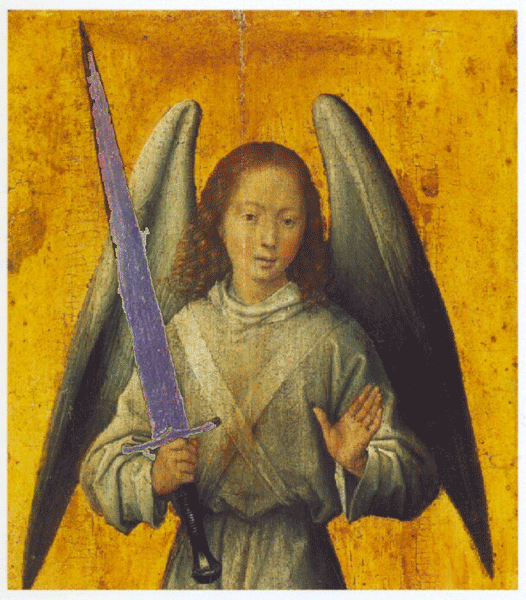
There does appear to be a fuller there, but we might also be seeing brush strokes. Thanks for posting this, Peter. It's exactly what I've been looking for with another project in mind.
 Attachment: 189.41 KB
Attachment: 189.41 KB


Re: The Memling painting:
It is a beautiful sword, and rendered with great skill by the artist. For what it's worth, I've always thought I could see a fuller on that blade, merging into a midrib as you look towards the point. Difficult to know for certain, though, so I'll make a note to have a proper look next time I'm down at the Wallace Collection.
I forgot to say, by the way, that the prototype Principe looks absolutely superb in the photos and should be worthy of the originals, especially if the edge geometry is reproduced faithfully as Peter suggests. I've often wondered how these blades would fare in a test-cutting exercise compared with, say, a good XIIa, XIIIa or XIIIb. My guess is that they would give a pretty good account of themselves based upon all of the factors discussed in this thread so far. So, if any of you wish to share your findings in this area I, for one, would be delighted to see the results!
It is a beautiful sword, and rendered with great skill by the artist. For what it's worth, I've always thought I could see a fuller on that blade, merging into a midrib as you look towards the point. Difficult to know for certain, though, so I'll make a note to have a proper look next time I'm down at the Wallace Collection.
I forgot to say, by the way, that the prototype Principe looks absolutely superb in the photos and should be worthy of the originals, especially if the edge geometry is reproduced faithfully as Peter suggests. I've often wondered how these blades would fare in a test-cutting exercise compared with, say, a good XIIa, XIIIa or XIIIb. My guess is that they would give a pretty good account of themselves based upon all of the factors discussed in this thread so far. So, if any of you wish to share your findings in this area I, for one, would be delighted to see the results!
Thank you Clive,
I am pretty exited to get the first prototype blades of the XVIIIc to try out. It is one of these type of swords that can bring about an almost tingling feeling in the fingers when you grasp it. I hope that we can come close to this with the Principe.
Sean, thank you for that adjusted image. I see the fuller clearly now. Over the years with all my visits to the Wallace Collection, I have never seen this painting. It is a must for the next visit, especially since Memling is my favorite painter of this period.
Perhaps the blade even has a triple fullered ricasso? That would be nice! It would bring it even further away from the topic of this discussion, but what a nice blade! (and now the blade smith gears start to crunch in the back of my mind: what a great design concept to try out!)
Memling depicts several beautiful swords in his work. His painting of dark reflective surface of polished steel is wonderful to see. The dark blue, almost black surface of armour is very realistic. It makes me wonder about bluing of blades. Heat bluing would involve a temper that is very soft: good spring temper, but not great in edge retention. Appropriate for armour, but rather low for an edge. Then again, test of swords show hardness values that are often lower than we see in contemporary swords.
I am pretty exited to get the first prototype blades of the XVIIIc to try out. It is one of these type of swords that can bring about an almost tingling feeling in the fingers when you grasp it. I hope that we can come close to this with the Principe.
Sean, thank you for that adjusted image. I see the fuller clearly now. Over the years with all my visits to the Wallace Collection, I have never seen this painting. It is a must for the next visit, especially since Memling is my favorite painter of this period.
Perhaps the blade even has a triple fullered ricasso? That would be nice! It would bring it even further away from the topic of this discussion, but what a nice blade! (and now the blade smith gears start to crunch in the back of my mind: what a great design concept to try out!)
Memling depicts several beautiful swords in his work. His painting of dark reflective surface of polished steel is wonderful to see. The dark blue, almost black surface of armour is very realistic. It makes me wonder about bluing of blades. Heat bluing would involve a temper that is very soft: good spring temper, but not great in edge retention. Appropriate for armour, but rather low for an edge. Then again, test of swords show hardness values that are often lower than we see in contemporary swords.
| P. Norton wrote: |
| I think this might be the same sword from the Alexandria arsenal.
[...] Metropolitan Museum of Art in New York. [...] |
Oops. I should have done a little more homework before posting... :(
This is a different sword than the one at Leeds, (although another beautiful example of the type).
Anyway, I'm delighted to see Albion developing an XVIIIc blade (I've always loved this sub-type), and am eagerly awaiting the Principe. I want one very badly and will be calling Mike as soon as they become available for pre-order. :)
Now, Albion just needs to come out with a compact and powerful single-hand XVIII, like this one:
http://collections.royalarmouries.org/image.p...=4&x=1
| P. Norton wrote: |
|
.... Now, Albion just needs to come out with a compact and powerful single-hand XVIII, like this one: http://collections.royalarmouries.org/image.p...=4&x=1 |
Funny you should pick this blade. I know it well from a previous study trip to RA in Leeds. It was among the first swords I documented there. A very nice sword. Just like you say: compact and powerful. Hefty but lively. It is a well made sword of good quality. Surprisingly thin edges for such a stout blade (and this is not from rust: you can tell from the way the blade fits a tight slot in the guard).
I've been waiting years to see Albion make one like this and I have to say I'm not disappointed.
Here are some more photos of the one Peter made for the Solingen show.
(thanks to Jeroen for the photos)
[ Linked Image ]
[ Linked Image ]
Here are some more photos of the one Peter made for the Solingen show.
(thanks to Jeroen for the photos)
[ Linked Image ]
[ Linked Image ]
Last edited by Dan Dickinson on Fri 04 Jun, 2010 3:22 pm; edited 3 times in total
| P. Norton wrote: |
|
Now, Albion just needs to come out with a compact and powerful single-hand XVIII, like this one: http://collections.royalarmouries.org/image.p...=4&x=1 |
Ah... one of the Group A Castillon swords which are, in the main, superb cut and thrust weapons. The examples I've seen have all handled beautifully, and I imagine any of them would be extremely handy if you were to find yourself on a crowded battlefield. The Group A pieces all appear to be of Types XV and XVIII, although I haven't seen the whole corpus of them as they are spread quite far afield nowadays (has anyone actually seen all 80 swords from the Castillon Hoard? I only have photos of about 30 of them so far...).
Before I risk going off-topic, the big Type XVIIIc swords from the Alexandria Arsenal really do give you a tingling feeling when you hold one of them for the first time as you come to appreciate the sheer size of the blade and the quality of its design. There's one in a private collection that's shorter than the Leeds or the Met examples (105.41cm overall - this is Sword No. 13 in my 2003 article), but is no less impressive than either. It even retains a later (poss. 19th century) leather covering on the grip which goes a long way to helping us understand how the original must have felt.
Dan,
Superb photos. Thanks for posting them! The grip on the XVIIIc is just about how I imagined the Alexandrian ones to have appeared originally, based on contemporary effigial slabs, brasses and artwork, etc.
Superb photos. Thanks for posting them! The grip on the XVIIIc is just about how I imagined the Alexandrian ones to have appeared originally, based on contemporary effigial slabs, brasses and artwork, etc.
| Peter Johnsson wrote: |
| [...]
Funny you should pick this blade. I know it well from a previous study trip to RA in Leeds. It was among the first swords I documented there. A very nice sword. Just like you say: compact and powerful. Hefty but lively. It is a well made sword of good quality. Surprisingly thin edges for such a stout blade (and this is not from rust: you can tell from the way the blade fits a tight slot in the guard). |
I picked it because I really like the elegant simplicity and no-nonsense practicality of the design. It's possibly the nicest looking (and from the looks of it, the most effective) XVIII I've ever seen. Even though it's all-business, its aesthetics really speak to me.
I feel the same way about the aesthetics of all the Group A swords from the Castillon find: e.g. XV.5, XV.8, XV.11, and XVIII.6 in Records are all beautiful to my eyes. I also love XV.1 (inspiration for the Poitiers?), XVIII.3 (inspiration for the Kingmaker?), and especially the XVIIIb in the Bayerisches National museum which inspired the Munich. The XVIIIc at Leeds from the Alexandria arsenal also has an aesthetic quality which I feel drawn to, and like IX.3683, looks to be a *very* formidable fighting sword as well.
| Clive Thomas wrote: |
| [...]
Ah... one of the Group A Castillon swords which are, in the main, superb cut and thrust weapons. The examples I've seen have all handled beautifully, and I imagine any of them would be extremely handy if you were to find yourself on a crowded battlefield. The Group A pieces all appear to be of Types XV and XVIII, although I haven't seen the whole corpus of them as they are spread quite far afield nowadays (has anyone actually seen all 80 swords from the Castillon Hoard? I only have photos of about 30 of them so far...) [...] |
I should have known it was one of the Group A Dordogne swords! It has the same beautiful aesthetics. I just love these swords!
| Roger Hooper wrote: |
| Here is another XVIIIc made by Peter Johnsson, though not for Albion. I don't remember where I picked up this photo |
I didn't find a response on the soure of the photo that Roger posted. Mr. Johnsson made the pictured XVIIIc for the Masters of Fire Exhibition, which took place several years ago in Macao. The exhibition is mentioned in this thread (among others): http://www.myArmoury.com/talk/viewtopic.php?t...sters+fire
Here are photo's of that trio and the XVIIIc hilt.
As perfect as the other swords are, my favourite is the XVIIIc due to the extreme proportions of it's blade and the simplicity of it's hilt compared to the others, although as always with swords of this type there is so much more present in the design than may be apparent upon casual observation.
 Attachment: 44.85 KB
Attachment: 44.85 KB
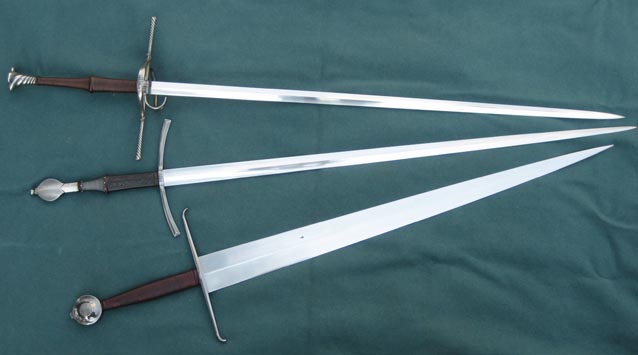
 Attachment: 69.97 KB
Attachment: 69.97 KB

As perfect as the other swords are, my favourite is the XVIIIc due to the extreme proportions of it's blade and the simplicity of it's hilt compared to the others, although as always with swords of this type there is so much more present in the design than may be apparent upon casual observation.


| Steve Grisetti wrote: | ||
I didn't find a response on the soure of the photo that Roger posted. Mr. Johnsson made the pictured XVIIIc for the Masters of Fire Exhibition, which took place several years ago in Macao. The exhibition is mentioned in this thread (among others): http://www.myArmoury.com/talk/viewtopic.php?t...sters+fire |
It was a great honor to be invited to the Masters of Fire exhibition. At one time I hoped to be able to attend the opening of the exhibition, but it proved to be much too costly a travel. It would have been great to see those swords gathered in one place. Antonio Cejunior did a great job organizing the whole event. Unfortunately I lent my only copy of the catalogue to a magazine editor and never got it back, so I have to rely on memory only...
The sword I made was an illustration or comment to the poem "Jabberwocky" by Lewis Carroll. It is the Vorpal Sword of the hero who braves the wild to seek out the dread monster. I love this poem and think it sums up both contemporary romance of the sword and some aspect of the eternal archetypical elements associated with the *Sword* and the *Hero*.
Obviously it is not meant to be a faithful replica of a historical sword or even sword type.
It does have something in common with those wide bladed war swords of type XVIIIc and XXII, but if it was to be classified according to Oakeshott´s typology I guess it would rather be a type XVIa of unusual proportions. As it is a contemporary sword more than anything else, a system to classify historical swords will not really apply easily.
The XVIIIc I made for the Solingen show in 2006 is however much influenced by my study 2004 of the Alexandria sword in the Ra in Leeds. Again, not an exact replica, but I could not have made this sword the way I did without first hand impressions of the original sword. As you may have guessed, I am fascinated by these wide bladed war swords of various types. They really carry some extreme expressions of the sword. The feel is hungry and powerful.
I attach some pics of the "Vorpal Sword", the type XVIIIc for Solingen 2006, and the type XXII for Solingen 2009:
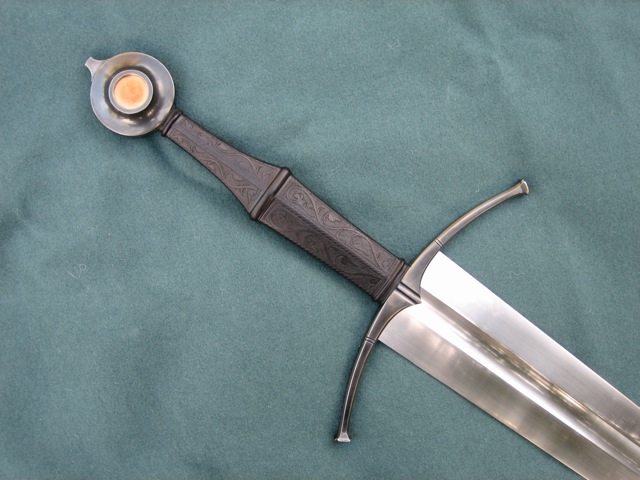
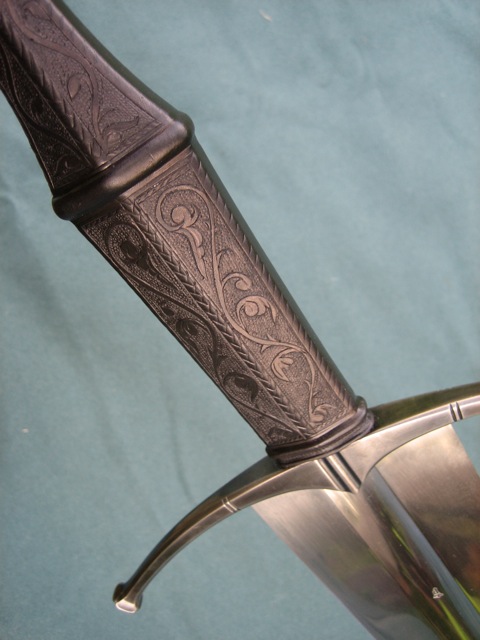

Photo by Lutz Hoffmeister
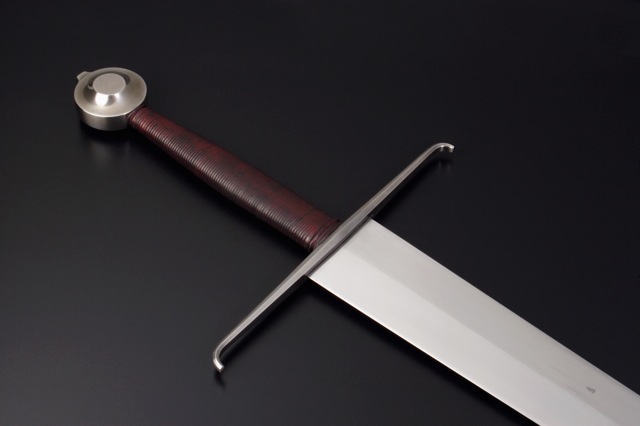
Photo by Lutz Hoffmeister
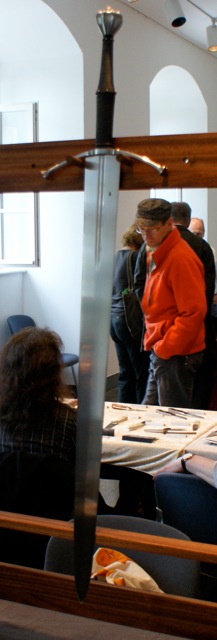
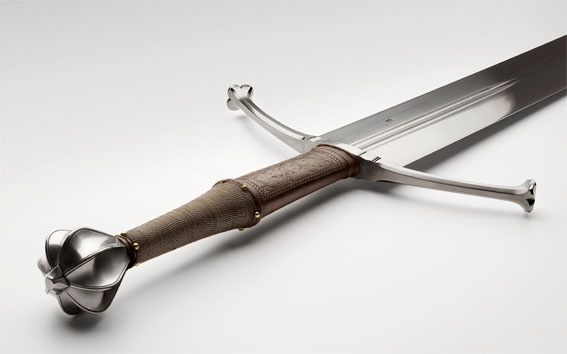
Photo by 1+1
| Peter Johnsson wrote: |
|
I attach some pics of the "Vorpal Sword", the type XVIIIc for Solingen 2006, and the type XXII for Solingen 2009: |
Peter,
Was the grip leather tooled after it was bound? These intricately tooled grips always fascinate me. I have found the issue of tooling leather before or after covering grips and scabbard cores to be one of the more torturous issues I have never decided upon.
Thanks anyway if you decide to decline answering as this could be considered a proprietary secret. I really love just seeing the photos of the finished work!
| Jared Smith wrote: |
|
Peter, Was the grip leather tooled after it was bound? These intricately tooled grips always fascinate me. I have found the issue of tooling leather before or after covering grips and scabbard cores to be one of the more torturous issues I have never decided upon. Thanks anyway if you decide to decline answering as this could be considered a proprietary secret. I really love just seeing the photos of the finished work! |
Hi Jared!
The tooling is all done after the leather is put on to the grip. It is made by a combination of cutting, stamping with pre cut stamps and free hand tooling.
One of these days I´ll put together a work in progress post on how to do this.
Peter,
Lovely tooling on the grips of your "Vorpal" sword and the Type XXII. The workmanship is absolutely outstanding, and it's always good to see a few more shots of the Type XVIIIc.
As you have probably guessed by now, I also have something of a fascination for these particular swords and seeing the Leeds sword some 16 years ago at the Tower of London (where it was then on display) prompted me to begin my research into the type. The outcome was of course the 2003 article for the Park Lane Arms Fair Catalogue, and my research remains very much an ongoing project.
I now know of 20 examples of the XVIIIc type with Arabic inscriptions, although five of them are known only from late nineteenth / early twentieth century photographs and whose current whereabouts are unknown to me. Two of these would be easily recognised if they were to be rediscovered as they have suffered damage to the tips of their blades which is quite apparent in the photos. One is quite substantially damaged and is missing about 15cm of its tip. Another one from these vintage photographs has an octagonal pommel and appears to be even larger than the Leeds sword at around 121cm in overall length, making it the longest of the whole group.
Lovely tooling on the grips of your "Vorpal" sword and the Type XXII. The workmanship is absolutely outstanding, and it's always good to see a few more shots of the Type XVIIIc.
As you have probably guessed by now, I also have something of a fascination for these particular swords and seeing the Leeds sword some 16 years ago at the Tower of London (where it was then on display) prompted me to begin my research into the type. The outcome was of course the 2003 article for the Park Lane Arms Fair Catalogue, and my research remains very much an ongoing project.
I now know of 20 examples of the XVIIIc type with Arabic inscriptions, although five of them are known only from late nineteenth / early twentieth century photographs and whose current whereabouts are unknown to me. Two of these would be easily recognised if they were to be rediscovered as they have suffered damage to the tips of their blades which is quite apparent in the photos. One is quite substantially damaged and is missing about 15cm of its tip. Another one from these vintage photographs has an octagonal pommel and appears to be even larger than the Leeds sword at around 121cm in overall length, making it the longest of the whole group.
Page 3 of 3
You cannot post new topics in this forumYou cannot reply to topics in this forum
You cannot edit your posts in this forum
You cannot delete your posts in this forum
You cannot vote in polls in this forum
You cannot attach files in this forum
You can download files in this forum
All contents © Copyright 2003-2006 myArmoury.com — All rights reserved
Discussion forums powered by phpBB © The phpBB Group
Switch to the Full-featured Version of the forum
Discussion forums powered by phpBB © The phpBB Group
Switch to the Full-featured Version of the forum